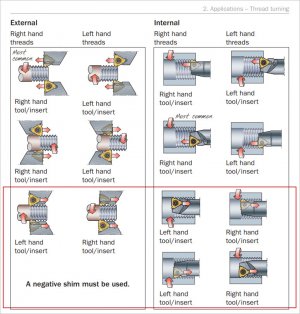I needed to cut an internal thread 12 TPI pitch and the ID is just over 1 in - 1.115 to be exact. It mates to a stub that has the male thread ( and I cannot alter or change that). The thread is 0.480 in long.
After some searching , I made an upside down threading tool boring bar.
Using my carriage stop I located the start point inside the bore..
The running in reverse I started cutting the thread.
Yes, I know lots of guys question the reverse running , but I'm cutting an aluminum alloy so no big forces involved here.
I got the part done OK, but after reflecting on my lack of visibility ( i.e. can't see what's going on) and the upward force on the cutting tool
it occurred to me that I should have put the tool right side up and machine the far side of the bore , not the near side.
So as an experiment, I made a second piece, using the far side and it was much better going I felt more confident too, about the progress
of the thread cutting.
I've had the SB 9 in lathe for several years and have read lots of notes, books, watch videos etc etc, but I've never seen anyone cutting on the far side using reverse rotation.
The work on the second piece went more quickly too
I thought I'd share this in case some one out there might find it useful.
After some searching , I made an upside down threading tool boring bar.
Using my carriage stop I located the start point inside the bore..
The running in reverse I started cutting the thread.
Yes, I know lots of guys question the reverse running , but I'm cutting an aluminum alloy so no big forces involved here.
I got the part done OK, but after reflecting on my lack of visibility ( i.e. can't see what's going on) and the upward force on the cutting tool
it occurred to me that I should have put the tool right side up and machine the far side of the bore , not the near side.
So as an experiment, I made a second piece, using the far side and it was much better going I felt more confident too, about the progress
of the thread cutting.
I've had the SB 9 in lathe for several years and have read lots of notes, books, watch videos etc etc, but I've never seen anyone cutting on the far side using reverse rotation.
The work on the second piece went more quickly too
I thought I'd share this in case some one out there might find it useful.


